La reimposta della password di WordPress è di solito un processo semplice. Tuttavia, a volte i metodi standard non funzionano, lasciandovi bloccati fuori dal vostro sito web.
Alcuni dei nostri lettori hanno riscontrato questo problema e ci hanno chiesto un consiglio su quale sia il modo migliore per accedere ai loro account. Fortunatamente, potete sempre utilizzare lo strumento phpMyAdmin nel pannello di controllo del vostro account di hosting per reimpostare la password direttamente dal database di WordPress.
In questo articolo vi mostreremo come reimpostare facilmente la password di WordPress da phpMyAdmin. Spiegheremo ogni passaggio in modo chiaro, assicurandoci che anche chi non ha familiarità con i database possa seguirlo con sicurezza.
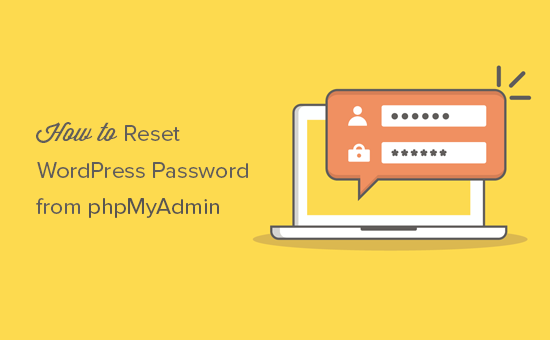
Perché resettare la password di WordPress da phpMyAdmin?
WordPress rende super facile il recupero di una password persa.
È sufficiente andare alla schermata di accesso del vostro sito web WordPress e cliccare sul link “Hai perso la password?”.
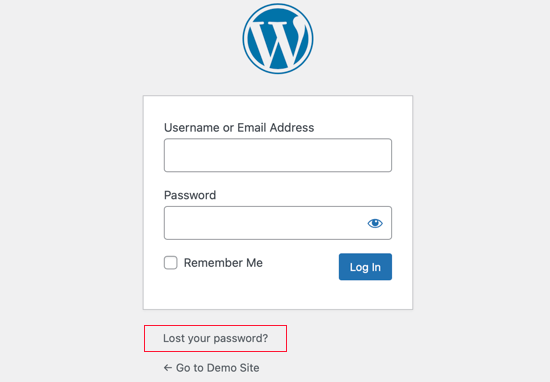
Facendo clic sul link si accede alla pagina di reimpostazione della password. Una volta inserito il nome utente o l’indirizzo e-mail, WordPress invierà un link per la reimpostazione della password all’indirizzo e-mail associato.
Tuttavia, se non avete accesso a quell’indirizzo e-mail o se il vostro sito WordPress non riesce a inviare un’e-mail, non sarete in grado di reimpostare la password.
In questa situazione, è necessario reimpostare la password di WordPress direttamente nel database. Il modo più semplice per farlo è usare phpMyAdmin.
Detto questo, vediamo come resettare facilmente una password di WordPress da phpMyAdmin.
Come resettare la password di WordPress da phpMyAdmin
Se non volete guardare il tutorial video, potete continuare a leggere la versione testuale qui sotto.
Per prima cosa, è necessario accedere al cruscotto cPanel del vostro account di hosting WordPress. Quindi, è necessario navigare nella sezione Database, dove è possibile fare clic sull’icona phpMyAdmin.
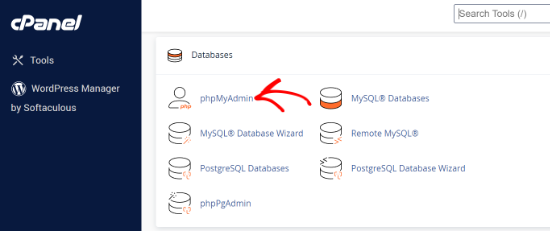
In questo modo si avvia l’applicazione phpMyAdmin.
Qui è necessario selezionare il database di WordPress dal riquadro di sinistra.
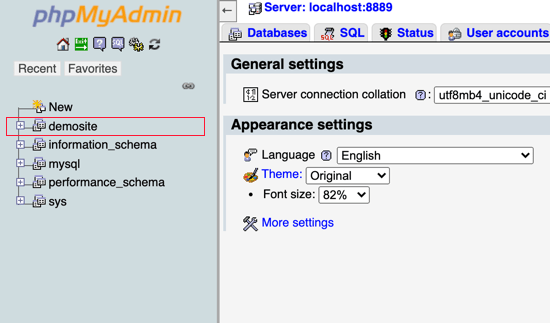
Ora viene visualizzato l’elenco delle tabelle del database di WordPress.
È necessario cercare la tabella wp_users in questo elenco e fare clic sul link “Sfoglia” accanto ad essa.
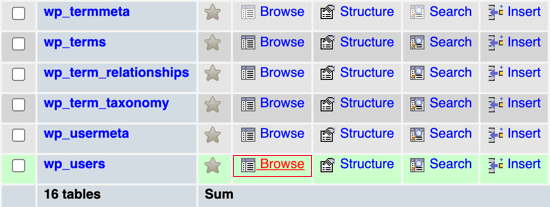
Nota: i nomi delle tabelle nel database di WordPress potrebbero avere un prefisso diverso da quello mostrato nell’immagine. La modifica dei prefissi delle tabelle può migliorare la sicurezza del vostro sito WordPress.
Ora si vedranno le righe della tabella degli utenti di WordPress. Fate clic sul pulsante di modifica accanto al nome utente di cui desiderate cambiare la password.
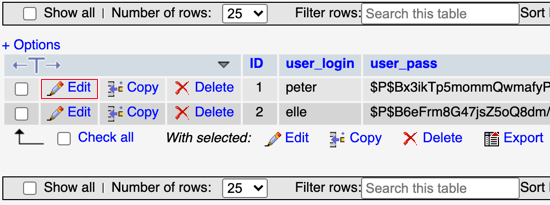
PhpMyAdmin mostrerà un modulo con tutti i campi delle informazioni dell’utente.
È necessario cancellare il valore del campo user_pass e sostituirlo con la nuova password. Nella colonna Funzione, selezionare MD5 dal menu a discesa e fare clic sul pulsante Vai in fondo al modulo.
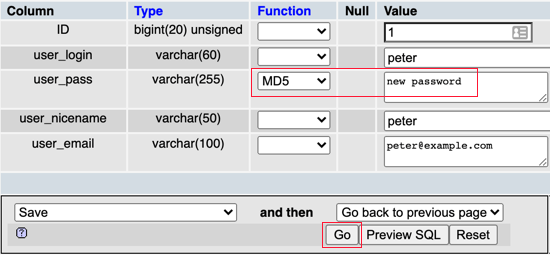
La password verrà crittografata utilizzando l’hash MD5 e poi verrà memorizzata nel database.
Congratulazioni! Avete cambiato con successo la password di WordPress usando phpMyAdmin.
Alcuni di voi si chiederanno perché abbiamo scelto l’hash MD5 per criptare la password. In precedenza WordPress utilizzava l’hash MD5 per crittografare le password, ma da WordPress 2.5 utilizza tecnologie di crittografia più forti.
Tuttavia, WordPress riconosce ancora l’MD5 per garantire la compatibilità con il passato. Non appena si accede utilizzando una stringa di password memorizzata come hash MD5, WordPress la modificherà automaticamente per utilizzare gli algoritmi di crittografia più recenti.
Guide di esperti sulle password in WordPress
Ora che sapete come reimpostare una password di WordPress da phpMyAdmin, potreste voler vedere altri articoli relativi alle password di WordPress.
- Come cambiare la password in WordPress (Guida per principianti)
- Come resettare le password di tutti gli utenti in WordPress
- Come personalizzare la pagina di reimpostazione della password di WordPress
- Come forzare gli utenti a cambiare la password in WordPress – Scadenza della password
- Password dimenticata? Come recuperare una password persa in WordPress
- Come forzare le password forti agli utenti in WordPress
- Come aggiungere l’autenticazione a due fattori in WordPress (metodo gratuito)
- Come consentire agli utenti di nascondere/mostrare le password nella schermata di accesso di WordPress
- Come gestire le password in modo facile e sicuro (Guida per principianti)
Speriamo che questo tutorial vi abbia aiutato a imparare come resettare una password di WordPress da phpMyAdmin. Potreste anche voler consultare la nostra guida definitiva alla sicurezza di WordPress, passo dopo passo, per mantenere il vostro sito WordPress al sicuro, oppure la nostra selezione di plugin indispensabili.
Se questo articolo vi è piaciuto, iscrivetevi al nostro canale YouTube per le esercitazioni video su WordPress. Potete trovarci anche su Twitter e Facebook.





Liang Huang
Thank you so much. The instructions were easy enough to follow. God bless you
Sonu
Really Helpfull
Luke
I have no WP_users at all. What do I do?
Abhishek Rawal
Thank You so much!
Worked like a charm
Stegemüller
I have fighting with passwords for hours. Then I found this guide and I was home free. Thank you very much.
Birgit
Super! Helped me a lot.
Harsha
Thank you!
Aarthi Rengaraj
Perfect tips and was very helpful in getting my client’s domains password changed. I was struggling and that “MD5” tag thing was actually missing. Thanks so much. This is the best place for any WordPress queries.
Susan
I am locked out of WordPress, my site is down. I can go into my c-panel. If I change the password to an encrypted password, do I now copy that and use it to log in? I really don’t get it? It is encrypted isn’t it? What do I now use to log into my WordPress? Do I use the log in name and email that is there in the c-panel?
Thanks
Charles Allen
Susan, the MD5 is like a secret recipe where one ingredient is missing. Let’s say we are pen pals and we are going to meet for the very first time. Since I have never seen you, I need a way to know that it is really you. One way to do this if you can send me a piece of homemade cake and a list of all but one secret ingredient. When we first meet, you will finally tell me what the secret ingredient is, and then I will bake my own cake with the exact recipe. If the cake I makes is exactly same as the cake you sent me, then I know you are really my pen pal. The MD5 is the completed cake, and the plain password you came up with is the secret ingredient. When you send the password to WordPress, it will use your secrete password ingredient to see if it can bake its own MD5 cake. When you log into WP, use the plain text password. Your WP user name is usually different from your cPanel name. If you forgot your user name, it will be listed as “user_login” in the database.
Jivanti
Hello there,
I seem to be getting the username is invalid commad everytime I try to login.
But the username and password is correct. It seemed like I might have created a different user name the first time I got locked out of my account. Or I forgot to renew my domain. I really can’t remember.
When I use a different username, I’m able to log in into WP dashboard and do theme changes but it is not reflecting in my current website.
The current dashboard does not have any of my old post or images.
I logged into to my cpanel and checked under the myphpadmin, there is 2 database. One of it contain the old posts and images. I tried the above method using the MD5, I’m still unable to acess the old user id and my old post.
I suspect the current active site is configured at the old database.
Another question, when I reset the password through MD5, do I copy this same new rest password that was generated in the phpadmin screen ( the long one) and paste it in the wp login screen. I tried it. It didn’t work.
Please help.
Randy
Works well.. Thank you!
slim
i just followed the process but it did not work out
hendryhowser
make sure your user_login is the same as user_nicename.
david h
Great help – thanks!
Eduardo Alfaro
Thank you very much guys! this was great
Harry
Sir I was changed my wordpress admin password in the same way but now it my dashboard is not opening it is showing a wrong password but I have changed it. Sir please help me………
yuseph
I tried to do it without choosing md5 and it won’t do it. Thanks much appreciated
Spock
Good advice, but spoken too rapidly. Slow down the delivery.
Charlie Sasser
An easier way is to use phpadmin and just change the email address to your current email and then go to regular login and click on “Forgot Password” and reset from email link. No need to worry about MP5 and all that stuff.
WPBeginner Support
This wouldn’t work if WordPress is unable to send password reset emails.
Admin
Greg
Thank you for the MD5 function in phpmyadmin.
Very helpful to me.
Akash
but im using defult url is it safe or not for my site
John
I wish people who make training videos would slow down they are always rushing through it as if they have a train to catch, So slow down and you will have great training videos…
Dee
Just wanted to say tell you how great your daily email is! Thanks
Editorial Staff
Thanks Dee
Admin
Peter
I don´t know what kind of hash it is, but it´s not default form of MD5. WordPress password hasher does the job fine.
Darshan Krishnan
Thank you very much, Syed and team WPBeginner.
My site was put in maintenance mode and hence password reset option did not work.
I changed the password as you suggested and everything is back to normal.
Much thanks for the awesome content.
Manoj
Really would like to say thank you as I find it really hard to change the password of my site
John
Awesome, thank you very much this has been a massive help
Ssk
Awesome! Helped me reset my password when I kept getting the “Host disabled the mail () function” error.
Luis
Hi! I’m s using mamp as local host, and i’m having some troubles with it: I can’t recover my wordpress password by setting a new one on phpMyadmin. It shows that the password row has been updated to the new one I chose, but it is not recognized by wordpress.org when i try to log in. Can’t figure out what may be the problem. I’m giving up on hosting my site on MAMP. I’ve seen that I can create a new database with cPanel, since I’m paying for hosting service from namecheap. What do you suggest for starting a new project from zero? Thanks a lot!
Sieu Nguyen
Thanks you. I lost my password and I used this way to create a new password.
Benji
Unfortunately this isn’t working for me. I’m doing exactly what your asking, but when I made a new password using the MD5 Hash and copy and paste that new password in the field > save by hitting Go > then go to refresh my Website admin log in page, I enter the new password and still tells me I’ve entered the wrong password??? I’ve tried email recovery but never get sent an email… So painful!
Any idea’s?
Joe
I’m getting this too, it is driving me mad! Would really appreciate some help on this
Dave
You don’t use the hashed password. Let’s say you set your new password to “letmeinalready,” choose MD5, and save it. You wouldn’t use that hashed password to get in – you’d use “letmeinalready”
Linda
Same problem here. I have followed all instructions to a T and it’s just not working. Can my web host chat help me? Me web developer has disappeared with this information.
WPBeginner Support
Yes, if you reach out to your hosting provider they should have access to update your password for you
Erik Chhuo
wow, this is way too fast a video clip for me. Just can’t follow any. Didn’t even where to start.
Karen
Do you have to be logged into your admin to start with? I can’t even log in to do any of the above!!!
Heather
This is not working for me…still cannot login
jan
awesome, very old post, but still being read and replied to!
I used Duplicator to copy a one-page WP-site to localhost (XAMPP). Made a new database as instructed, password and everything.
When I try to enter local password (or is it the database password?), screen reverts to site published on cloud host.
Localhost DB has two entries: for Duplicator (prefix 2ecxx_) and what I thought was local copy (prefix wp_). But the ‘local’ DB _wp entries are actually referring to the cloud hosting environment.
Tried to change wp_user username en PW (MD5), but does not work
Changed siteurl in _wp_options to localhost, does not help
When I use 2eczz_users username and PW, page also moves back to site published in the cloud
stalony
Does this tutorial still relevant in 2017 ????
WPBeginner Support
Yes, it is.
Admin
Mohamed Gees
Thanks A lot, VERY INFORMATIVE ARTICLE, i was up and down last two days. . you saved me. Thanks again
Ringo
Really would like to say thank you as I find it really hard to change the password of my site
Qamar Naveed
Very informative article, i was stuck at database name, finally found with the help of this article.
Rachel Ortiz
Thanks so much. I am NOT a programmer whatsoever and these instructions were easy enough for me to get. This was a lifesaver.
Kareem Said
Thanks for the MD5 tip
Denis
This was very good. thanks !
Esteban Zerega
great contribution master! thank you so much!
Venkat
It’s Awesome bro..you saved my time. Its working fine for me
Tamara
I have followed the steps exactly and still can’t log in. Is there anything else I can do?
Csbr
The layout has changed a lot since this was posted- the admin tab or the browse tabs are nowhere to be seen..
Charles Kinga
Lot of thanx guys. It has worked for me and was stranded on my website security but now am fine.
The procedures are very user friendly hence easy to understand.
God bless
Camille
I did all those steps but I still cannot login into my wordpress wp-admin. Can you help me? Thanks.
John Osmond
Why not use the md5 hash that is already there in phpMyAdmin? Just open the drop-down in the functions column. I will md5 hash your plain text password for you.
Sara Moreira
genuine <3
thank you for all the know-how and tricks you share!
WPBeginner Support
Thanks Sara we are glad you find them useful. Don’t forget to follow us on Facebook for more WordPress tips and tutorials.
we are glad you find them useful. Don’t forget to follow us on Facebook for more WordPress tips and tutorials.
Admin
Elgin Martinez
Sir/Madam
I am interested in becoming a professional web designer using the WordPress platform but don’t know where to start. Any advise thanks.
Frank Nsia
Thank you so much. The instructions were easy enough for even me to follow. God bless you